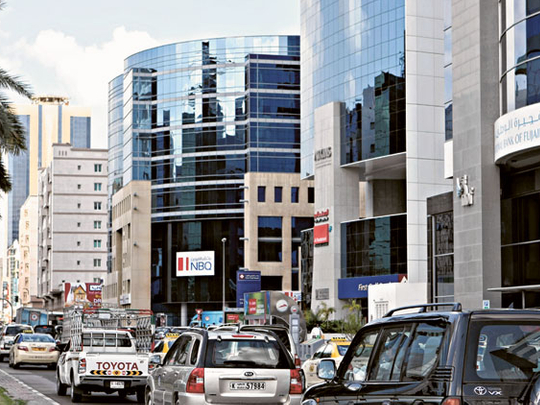
Dubai: UAE banks saw another year of modest profit growth as continued high provisioning and lower fee incomes took a heavy toll on performance.
While some managed to keep their profitability above the trend, at least in a few cases larger banks' profits were largely driven by one-off incomes from asset sales or treasury operations.
Although leading banks suffered a decline in the ratio of non-performing assets to total assets (NPL ratio), for the fourth consecutive year significant shares of their earnings had to be set aside to meet provisioning requirements on impaired assets and investments.
High provisions
Despite the declining NPL ratios, larger banks continued to report high provisions in absolute terms as major government owned entities such as Dubai Holding and its subsidiaries and a few other corporates are restructuring their debt.
Emirates NBD, the UAE's largest bank by assets, earned a net profit of Dh2.48 billion in 2011, up 6 per cent over the Dh2.33 billion earned in 2010.
In the fourth quarter provisions rose to Dh1.06 billion from Dh201 million in the year-ago quarter. The impairment charge increased to Dh4.97 billion over the previous year's Dh3.19 billion.
With more corporate restructurings in the pipeline, the bank expects its NPL ratio to increase from around 13 per cent last year to 14 to 15 per cent this year.
Decline in loan loss
The bank said its acquisition of Dubai Bank had zero impact on the bank's profit and loss account and NPLs.
As part of the fair value adjustment Emirates NBD Group received a Dh2.8 billion deposit from the UAE Ministry of Finance at discounted rates comparable to market rates.
Additionally the government of Dubai has provided a guarantee for any losses at the date of acquisition and any future losses relating to the assets and liabilities on the date of acquisition for the next seven years.
Most Abu Dhabi banks have reported a consistent decline in loan loss provisions and this is expected to continue this year.
National Bank of Abu Dhabi (NBAD) reported collective provisions of Dh2.32 billion, or 1.5 per cent of the performing credit risk-weighted assets.
The overall non-performing loans increased to Dh4.839 billion, or 2.94 per cent of the loan book.
The bank's net profit for 2011 rose a modest 0.8 per cent on year to Dh3.71 billion.
Abu Dhabi Commercial Bank (ADCB) reported a Dh3 billion net profit last year, up from Dh391 million the previous year.
The massive jump was partly aided by the income from the sale of its stake in Malaysia's RHB Capital. The bank gained Dh1.31 billion from the RHB stake sale.
Additionally a significant drop in impairments also boosted profits.
Provisions fell to Dh2.08 billion last year from Dh2.86 billion in 2010.
"We continued to pro-actively manage credit quality and we are pleased to see signs of improvement in asset quality with reported NPLs reducing," said Ala'a Eraiqat, ADCB chief executive officer.
Fee incomes
The bank has come a long way in de-risking its balance sheet.
Last year it substantially reduced its exposure to investments in credit default swaps (CDS) from Dh1.45 billion in 2010 to Dh55 million.
Almost all banks reported that growth in interest income was seriously offset by a sharp decline in fee income.
Union National Bank reported a full-year net profit of Dh1.5 billion, up 11 per cent over 2010.
Net interest income together with net income from Islamic financing was up 22.5 per cent. But it was partly offset by a 25 per cent decline in non-interest income.
While banking analysts and rating agencies agree that banks have been earnest in addressing asset quality challenges, many said the upcoming debt restructurings by corporates and GREs will adversely impact the banks' asset quality and liquidity.
The restructuring of some of the GREs where the government has stopped support is expected to pose fresh challenges to balance sheet health.
Two recent cases are the debt restructuring of Dubai Group and Dubai Drydocks.
Both entities were reportedly asked to renegotiate their debt without government support.
"The absence of government support to debt restructuring is expected to cause tighter liquidity conditions in the UAE banking sector," said Jean-Michel Saliba, an economist with Bank of America Merrill Lynch.
The first half of 2011 saw a solid recovery in the externally driven sectors of the economy, as well as unprecedented inflows of deposits into the UAE, given its safe haven status amid Arab unrest.
Analysts say both these factors are unlikely to be supportive to the same extent in 2012.
Additionally, the geopolitical threat from the Iran crisis could further tighten liquidity and weaken profitability.
Challenges
Analysts say the UAE banks could face future asset quality challenges from restructured loans.
"The significant increase in the renegotiated private sector loans hides the true extent of the banks' asset quality problems.
"Some of these loans may re-emerge as non-performing loans," rating agency Fitch said in a recent review of the banking sector.
Rating agency Standard & Poor's said improved loans to deposit ratios and high capitalisation levels are seen as the core strengths of the banking sector. With low external borrowing levels, analysts say banks' own refinancing requirements are manageable.
Borrowings
"The banking system's net external borrowings have fallen over the past few years and we believe the refinancing requirements of the local banks are largely manageable, particularly for Abu Dhabi institutions," said Timucin Engin, Associate Director, Rating Analytical Financial Institutions at S&P.
S&P recently expressed its satisfaction on the overall capitalisation levels of Gulf banks that are significantly higher than the new Basel III requirements and the composition of bank capital in the GCC is generally of high quality.











